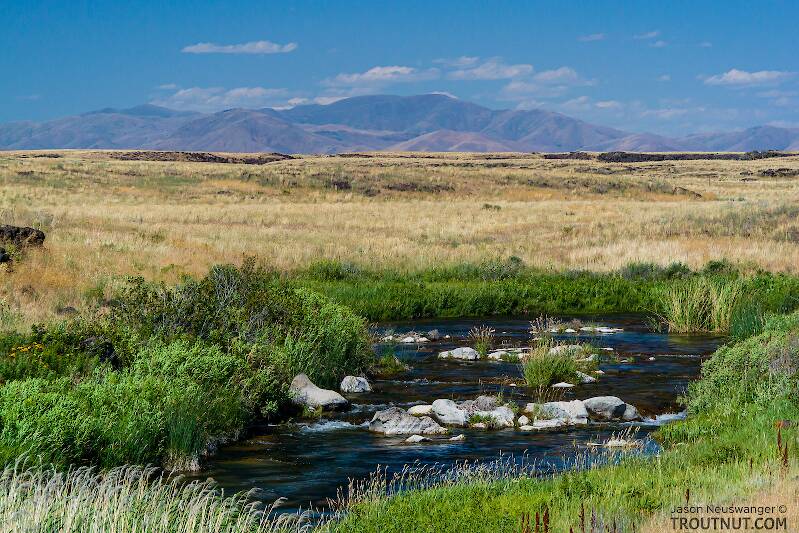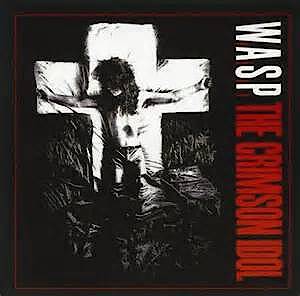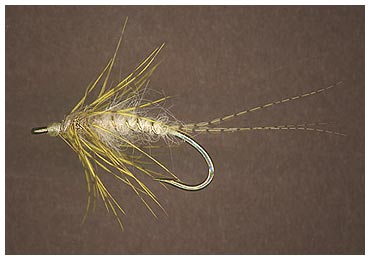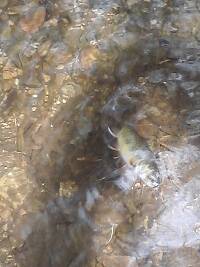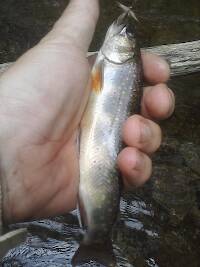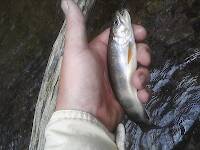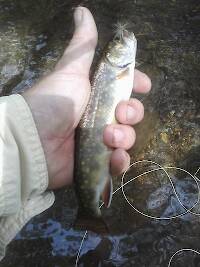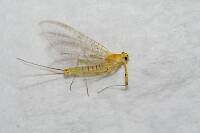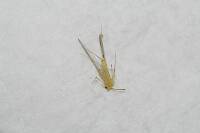
Blue-winged Olives
Baetis
Tiny Baetis mayflies are perhaps the most commonly encountered and imitated by anglers on all American trout streams due to their great abundance, widespread distribution, and trout-friendly emergence habits.
Featured on the forum

This specimen keys pretty easily to Onocosmoecus, and it closely resembles a specimen from Alaska which caddis expert Dave Ruiter recognized as this genus. As with that specimen, the only species in the genus documented in this area is Onocosmoecus unicolor, but Dave suggested for that specimen that there might be multiple not-yet-distinguished species under the unicolor umbrella and it would be best to stick with the genus-level ID. I'm doing the same for this one.

Troutnut is a project started in 2003 by salmonid ecologist Jason "Troutnut" Neuswanger to help anglers and
fly tyers unabashedly embrace the entomological side of the sport. Learn more about Troutnut or
support the project for an enhanced experience here.
Adirman on Jun 16, 2012June 16th, 2012, 6:46 am EDT
Guys;
What are some of your favorite dry fly patterns for fishing Light Cahills? to me, they look very similar to Sulphers and Golden Drakes. Is there a searching pattern that imitates all of these fairly well out there or am I generalizing there similarities too much?
Thanks a bunch,
Adirman
What are some of your favorite dry fly patterns for fishing Light Cahills? to me, they look very similar to Sulphers and Golden Drakes. Is there a searching pattern that imitates all of these fairly well out there or am I generalizing there similarities too much?
Thanks a bunch,
Adirman
Martinlf on Jun 16, 2012June 16th, 2012, 8:07 am EDT
I believe that a well-presented creamy yellow comparadun or parachute in the right size will take many fish rising to these hatches. But perhaps not all. Some fish, like some people, seem to possess more discriminating palates.
But it's hard to tell exactly what got this or that fish to rise. Was it the size of the tippet? The angle or manner of presentation? The exact color of the body? The hackle or lack of it? The match to the specific aspect of emergence? The wing profile? Each angler decides, and I'd venture that some of our most insightful revelations are pure superstition.
So, the ultimate answer for each of us may just lie in trial and error, adding experience and confidence as we find something that works. And confidence and experience, along with persistence, are very important additions to any fly pattern.
Finally I'd note that these words of wisdom ironically come from a person who sometimes blends his own dubbing and dyes his own materials, all in the quest to come up with a magic bullet. Superstition? Probably. Confidence gainer? Frequently.
But it's hard to tell exactly what got this or that fish to rise. Was it the size of the tippet? The angle or manner of presentation? The exact color of the body? The hackle or lack of it? The match to the specific aspect of emergence? The wing profile? Each angler decides, and I'd venture that some of our most insightful revelations are pure superstition.
So, the ultimate answer for each of us may just lie in trial and error, adding experience and confidence as we find something that works. And confidence and experience, along with persistence, are very important additions to any fly pattern.
Finally I'd note that these words of wisdom ironically come from a person who sometimes blends his own dubbing and dyes his own materials, all in the quest to come up with a magic bullet. Superstition? Probably. Confidence gainer? Frequently.
"He spread them a yard and a half. 'And every one that got away is this big.'"
--Fred Chappell
--Fred Chappell
Entoman on Jun 16, 2012June 16th, 2012, 8:54 am EDT
Hi Adirman,
Searching patterns or general attractors by definition are as the name implies. Humpies, Wulffs, Parachutes, and traditional Catskill patterns all have their place. Oh, and don't forget them soft hackles fished in the film! They can be deadly searching patterns.
It's probably good advice going smaller and lighter as the season progresses (though I have found the fish don't always agree). Get your hands on a few small Blonde Humpies and give them a try.
I glean from experienced eastern anglers that the pale Summer heptageniids rarely hatch in numbers dense enough to cause selectivity, so a general attractor you have confidence in may be the way to go. Out West, some rivers have hatches of these pale critters that come in prodigious numbers requiring more imitative flies. In these situations I prefer slant wing thorax duns (heptageniid wings are more rakish than other families as a general rule) or a good matching flymph fished in the film. If you are fortunate to run into a hatch dense enough to cause the fish to dial in, you might consider these patterns or something similar that match size and color.
One final bit of advice - if only a few duns are trickling off here and there and fish don't seem to care about them (or your attractor dries), don't forget to try a good beetle or ant pattern! Sometimes they are just the ticket.
Searching patterns or general attractors by definition are as the name implies. Humpies, Wulffs, Parachutes, and traditional Catskill patterns all have their place. Oh, and don't forget them soft hackles fished in the film! They can be deadly searching patterns.
It's probably good advice going smaller and lighter as the season progresses (though I have found the fish don't always agree). Get your hands on a few small Blonde Humpies and give them a try.
I glean from experienced eastern anglers that the pale Summer heptageniids rarely hatch in numbers dense enough to cause selectivity, so a general attractor you have confidence in may be the way to go. Out West, some rivers have hatches of these pale critters that come in prodigious numbers requiring more imitative flies. In these situations I prefer slant wing thorax duns (heptageniid wings are more rakish than other families as a general rule) or a good matching flymph fished in the film. If you are fortunate to run into a hatch dense enough to cause the fish to dial in, you might consider these patterns or something similar that match size and color.
One final bit of advice - if only a few duns are trickling off here and there and fish don't seem to care about them (or your attractor dries), don't forget to try a good beetle or ant pattern! Sometimes they are just the ticket.
"It's not that I find fishing so important, it's just that I find all other endeavors of Man equally unimportant... And not nearly as much fun!" Robert Traver, Anatomy of a Fisherman
Jmd123 on Jun 16, 2012June 16th, 2012, 9:42 am EDT
Here in northern lower Michigan, our Light Cahill hatches are just starting. I fished the traditional Light Cahill pattern - wood duck tail, cream body, cream hackle, wood duck wings - in size 12 and got a 16-incher on it two nights ago, plus one lost nearly that big. I don't have a local Hex hatch situation (for trout, anyway) but these Light Cahills - I believe Stenonema canadense - can get every fish in the river feeding on the surface just like the Hex. They almost seem to glow as they hover above the surface in the twilight. Most definitely one of my favorite hatches!
Jonathon
Jonathon
No matter how big the one you just caught is, there's always a bigger one out there somewhere...
Adirman on Jun 16, 2012June 16th, 2012, 9:51 am EDT
Thanks guys! Entoman, I know I can always count on you for good advice!!
Let me as you this if I may: when you fish a soft hackle and wish to specifically keep it in the film such as a flymph, how do you prevent it from sinking too much? Do you dress the top area around the knot w/ a bit of floatant and/or also the leader a bit?
Thanks again,
Adirman
Let me as you this if I may: when you fish a soft hackle and wish to specifically keep it in the film such as a flymph, how do you prevent it from sinking too much? Do you dress the top area around the knot w/ a bit of floatant and/or also the leader a bit?
Thanks again,
Adirman
Entoman on Jun 16, 2012June 16th, 2012, 10:04 am EDT
Adir -
Dress them on dry fly hooks and use a kerchief to keep them dry (I have been known to use desiccant powder from time to time if the fish really want them up and aren't put off by the residue).
BTW - For those that may want to look on the hatch pages to see the bug Jon is referring to, Stenonema canadense is now Stenacron interpunctatum.
Dress them on dry fly hooks and use a kerchief to keep them dry (I have been known to use desiccant powder from time to time if the fish really want them up and aren't put off by the residue).
BTW - For those that may want to look on the hatch pages to see the bug Jon is referring to, Stenonema canadense is now Stenacron interpunctatum.
"It's not that I find fishing so important, it's just that I find all other endeavors of Man equally unimportant... And not nearly as much fun!" Robert Traver, Anatomy of a Fisherman
Entoman on Jun 16, 2012June 16th, 2012, 5:56 pm EDT
John -
Cool flies & photos! So you are a plier of the natural wand, huh? Very nice...
BTW - What kind of hair is that? Looks very cream with very tiny black tips. To me, the hair choice makes the fly on the comparadun pattern. You have a winner there for the Cahill species.
Cool flies & photos! So you are a plier of the natural wand, huh? Very nice...
BTW - What kind of hair is that? Looks very cream with very tiny black tips. To me, the hair choice makes the fly on the comparadun pattern. You have a winner there for the Cahill species.
"It's not that I find fishing so important, it's just that I find all other endeavors of Man equally unimportant... And not nearly as much fun!" Robert Traver, Anatomy of a Fisherman
Adirman on Jun 17, 2012June 17th, 2012, 1:47 am EDT
Wifly;
Nice pic of your flies!!
Nice pic of your flies!!
Wiflyfisher on Jun 17, 2012June 17th, 2012, 2:33 am EDT
Kurt, it is one of many pieces of elk hair from BRF.
Last night after storms rolled through I went back down to the river. Not much happening so at dusk so I tied on a large extended body Hex comparadun and had a beautiful 22" brown devour it. I didn't stay to see if any hatch was going to start, the skitters were out in force.
The bamboo fly rod is a blank from Dennis Stone that I finished over the winter months. It is a Granger 8642 taper, 8'6", 5 wt.
Last night after storms rolled through I went back down to the river. Not much happening so at dusk so I tied on a large extended body Hex comparadun and had a beautiful 22" brown devour it. I didn't stay to see if any hatch was going to start, the skitters were out in force.
The bamboo fly rod is a blank from Dennis Stone that I finished over the winter months. It is a Granger 8642 taper, 8'6", 5 wt.
John S.
https://WiFlyFisher.com
https://WiFlyFisher.com
Jmd123 on Jun 17, 2012June 17th, 2012, 10:51 am EDT
"...Stenonema canadense is now Stenacron interpunctatum."
Aaaah, there go those danged taxonomists again! Good thing the fish don't care...
Jonathon
P.S. Didn't see any the last two nights, or much of anything hatching for that matter. Friday night I pulled out the old secret weapon, a #12 Royal Wulff, and a 15-incher fell for it.
Aaaah, there go those danged taxonomists again! Good thing the fish don't care...
Jonathon
P.S. Didn't see any the last two nights, or much of anything hatching for that matter. Friday night I pulled out the old secret weapon, a #12 Royal Wulff, and a 15-incher fell for it.
No matter how big the one you just caught is, there's always a bigger one out there somewhere...
Wiflyfisher on Jun 17, 2012June 17th, 2012, 11:43 am EDT
P.S. Didn't see any the last two nights, or much of anything hatching for that matter. Friday night I pulled out the old secret weapon, a #12 Royal Wulff, and a 15-incher fell for it.
In the last 2 days I have also caught 4 really, really nice trout on these when there was nothing hatching (Royal Trude)...


John S.
https://WiFlyFisher.com
https://WiFlyFisher.com
Jmd123 on Jun 17, 2012June 17th, 2012, 12:10 pm EDT
Nice flies John! I haven't fished the Trude lately, and I'm due for a tying session...I have had much success in the past with Royal Coachman parachutes as well. What is it about this "Royal" pattern? It's been "the old secret weapon" for me for over 20 years, works on brookies, browns, and rainbows alike, especially lately. It's been my "clutch" fly many times this year alone.
Another which is beginning to produce again is the old White Wulff, size 10-12. Getting back to our Light Cahill discussion, a #12 in this pattern works very well during our Stenacron interpunctatum (I suppose...) hatches which are just getting started. Last night a rainbow probably 12 inches long took one in a nice log complex, came up on the other side of a log, and popped it off the 4x tippet...shoulda cut back at dark!
Jonathon
Another which is beginning to produce again is the old White Wulff, size 10-12. Getting back to our Light Cahill discussion, a #12 in this pattern works very well during our Stenacron interpunctatum (I suppose...) hatches which are just getting started. Last night a rainbow probably 12 inches long took one in a nice log complex, came up on the other side of a log, and popped it off the 4x tippet...shoulda cut back at dark!
Jonathon
No matter how big the one you just caught is, there's always a bigger one out there somewhere...
TNEAL on Jun 19, 2012June 19th, 2012, 9:52 am EDT
The Roberts Drake is just such a fly to imitate all fof them (and more) fairly well. If you need tying instructions, let me know.
Adirman on Jun 19, 2012June 19th, 2012, 12:54 pm EDT
Yes sir, that would be great!!
Thanks so much,
Adirman
Thanks so much,
Adirman
Softhackle on Jun 19, 2012June 19th, 2012, 4:48 pm EDT
"I have the highest respect for the skilled wet-fly fisherman, as he has mastered an art of very great difficulty." Edward R. Hewitt
Flymphs, Soft-hackles and Spiders: http://www.troutnut.com/libstudio/FS&S/index.html
Flymphs, Soft-hackles and Spiders: http://www.troutnut.com/libstudio/FS&S/index.html
Adirman on Jun 19, 2012June 19th, 2012, 5:29 pm EDT
Mark;
I'm going up to the Adirondacks this weekend to fish and i was wondering if you thought that some of your soft hackle patterns might be effective in those mountain streams up there and if so, which ones? Last year, I caught a bunch using classic dries and wets but as always, trying to vary my methods to amuse myself a bit so thought i might try something else. What do you think?
Thanks for your help, as always,
Adirman
I'm going up to the Adirondacks this weekend to fish and i was wondering if you thought that some of your soft hackle patterns might be effective in those mountain streams up there and if so, which ones? Last year, I caught a bunch using classic dries and wets but as always, trying to vary my methods to amuse myself a bit so thought i might try something else. What do you think?
Thanks for your help, as always,
Adirman
Softhackle on Jun 20, 2012June 20th, 2012, 6:35 am EDT
Hi,
It's been quite some time since I've traveled into the Adirondacks, however if I remember correctly, their hatches are a bit behind what is common in the Catskills. I believe sulfurs, cahills, yellow stone flies, Little olives, and perhaps some green drakes may be hatching and active. I guess it depends upon where you are. Usefull patterns may be these:
http://www.troutnut.com/libstudio/FS&S/html/cream_soft-hackle.html
http://www.troutnut.com/libstudio/FS&S/html/li_l_dorothy.html
http://www.troutnut.com/libstudio/FS&S/html/lt__snipe___yellow.html
http://www.troutnut.com/libstudio/FS&S/html/sulfur_soft-hackle.html
http://www.troutnut.com/libstudio/FS&S/html/tup_s_indispensible.html
http://www.troutnut.com/libstudio/FS&S/html/little_olive_flymph.html
Also that flymph I posted above should be considered. This style of fly could also be adapted to imitate those yellow stone flies by adjusting the colors of the body and hackle and hook size to match the natural. If you want to adjust it for a stone fly imitation, I'd omit the tail.
You need to pick which of these patterns floats your boat. It may be just a few, or all.
Let us know how you do!
Mark
It's been quite some time since I've traveled into the Adirondacks, however if I remember correctly, their hatches are a bit behind what is common in the Catskills. I believe sulfurs, cahills, yellow stone flies, Little olives, and perhaps some green drakes may be hatching and active. I guess it depends upon where you are. Usefull patterns may be these:
http://www.troutnut.com/libstudio/FS&S/html/cream_soft-hackle.html
http://www.troutnut.com/libstudio/FS&S/html/li_l_dorothy.html
http://www.troutnut.com/libstudio/FS&S/html/lt__snipe___yellow.html
http://www.troutnut.com/libstudio/FS&S/html/sulfur_soft-hackle.html
http://www.troutnut.com/libstudio/FS&S/html/tup_s_indispensible.html
http://www.troutnut.com/libstudio/FS&S/html/little_olive_flymph.html
Also that flymph I posted above should be considered. This style of fly could also be adapted to imitate those yellow stone flies by adjusting the colors of the body and hackle and hook size to match the natural. If you want to adjust it for a stone fly imitation, I'd omit the tail.
You need to pick which of these patterns floats your boat. It may be just a few, or all.
Let us know how you do!
Mark
"I have the highest respect for the skilled wet-fly fisherman, as he has mastered an art of very great difficulty." Edward R. Hewitt
Flymphs, Soft-hackles and Spiders: http://www.troutnut.com/libstudio/FS&S/index.html
Flymphs, Soft-hackles and Spiders: http://www.troutnut.com/libstudio/FS&S/index.html
Adirman on Jun 20, 2012June 20th, 2012, 2:44 pm EDT
Mark;
Thanks for the info and I'll report back soon!!
Adirman
Thanks for the info and I'll report back soon!!
Adirman
Quick Reply
Related Discussions
Topic
Replies
Last Reply
5
Jan 10, 2017
by Martinlf
by Martinlf

